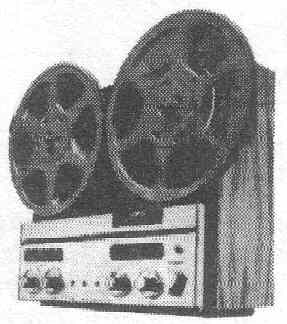
EQUIPMENT TEST REPORTS
By Hirsch-Houck Laboratories
REVOX A77
TAPE RECORDER
STEREO REVIEW
|
|
EQUIPMENT TEST REPORTS By Hirsch-Houck Laboratories REVOX A77 |
It is a pleasure to report that the widely acclaimed, but no longer available, Revox G36 Mk III tape recorder has actually been surpassed in performance by Revox's new Model A77. The A77 has fully solid-state electronics, a bias-oscillator frequency of 120 kHz (as opposed to 70 kHz for the G-36), and a new electronic motor-speed control. The A77 model we tested is a three-motor, four-track, two-speed recorder; however, it is substantially lighter and smaller than its predecessor. , The Revox A77 has its operating controls grouped into separate recording and playback areas. On the playback side are two rotary switches with concentric knobs. One switch establishes the playback mode stereo, either channel through both outputs, on both channels combined for mono. Playback level is controlled by the concentric knob. The other switch connects either the signal input or the output of the playback amplifiers to the output jacks in the rear. Two playback-equalisation characteristics are provided; NAB or IEC (for European tape recordings). The recording equalisation is to the NAB standards. The knob concentric with this switch is a playback channel-balance control.
On the right side of the recorder panel are two VU meters with real VU-meter characteristics. Adjacent to each is a red button of the push-an, push-off type. Depressing either channel's button alone records both inputs on that channel. If both buttons are depressed, a stereo recording is made. These supplement a record-interlock button, providing a double safety against accidental tape erasure. Recording levels may be set up before the tape is put into motion. When the recorder is in operation in the recording mode, the selected channel's VU meter (or meters) is illuminated.
Under each meter is a recording input-selector switch, with a concentric recording-level control. There are inputs for high and low-impedance microphones (with front-Panel jacks in parallel with rear phono connectors), radio (via a rear DIN connector), and auxiliary inputs with connectors in the rear. In addition, each switch has a position for recording the output of that channel combined with any additional source on to the other channel.
The Transport mechanism is operated by a row of five pushbuttons, activating solenoids to control fast speeds, stop, play and recording. A connector in the rear permits the use of an accessory remote-control unit for these functions. The tape speeds (71/2 and 33/4 ips) are selected by a switch that also controls a.c. power to the recorder. Each speed setting has two switch positions that set the tape tension to optimum values for 10 1/2 inch or smaller reels.
The servo-controlled drive system of the Revox A77 is unique and effective. The tape-drive capstan is powered by an eddy-current motor that delivers a high torque, free of the pulsations that are inevitable with any motor having a pole structure. The speed of this motor can be adjusted by varying a d.c. control voltage, with relatively little torque Variation The motor has a built-in tone Generator that produces an a.c. signal whose frequency is proportional to motor speed. This signal is amplified, limited, and applied to a discriminator, whose d.c. output is proportional to speed. This is further amplified and used to correct the motor speed. The change between 71/2 and 33/4 ips is accomplished electronically by shifting the -resonant frequency of the discriminator circuit. The chief advantages of this technique are independence from power-line voltage and frequency variations, as well as reduced flutter. Flutter of the A77 motor is inherently so low that the capstan can be driven directly from the motor shaft instead of through a separate belt-driven flywheel. According to the manufacturer, line voltage fluctuations of

Revox Corporation, 155 Michael Drive
Syosset New York 11791 New York USA
Tri-tel Associates Ltd Toronto Canada
C E Hammond & Company Limited
Lamb House Church Street Chiswick London W4
(Remark: Historical information, original published approx. end of 1969. Please note that the adresses and phone numbers may not be correct any longer.)